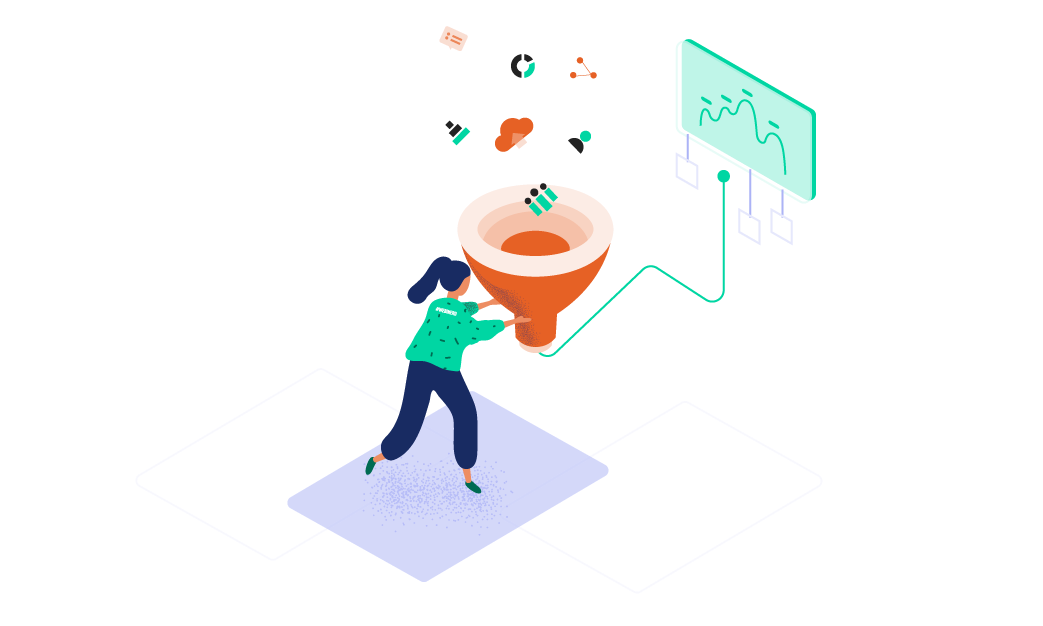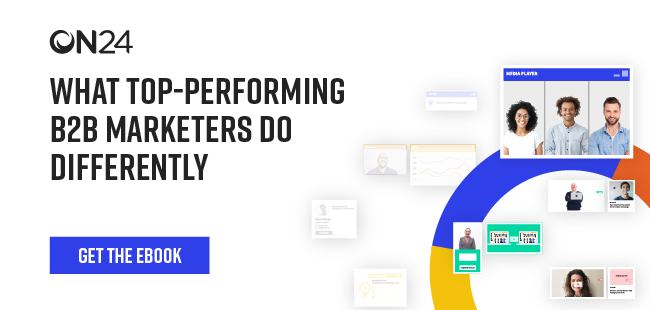Today’s B2B marketers face more challenges than ever before and finding ways to effectively navigate those challenges is key to any success. Those able to break through the noise and provide quality interactions with customers have found a way to set themselves apart from the rest of the pack.
So, how’d they do it?
We wanted to understand more about how top-performing marketers became “top performers,” so we joined forces with Heinz Marketing and Market2Marketers to research the behaviors and strategies of leading marketers that result in better customer experiences everywhere.
Together, we created the Experiences Everywhere Report, which surveyed over 130 B2B marketers from a variety of organizations in differing industries. Top-performing marketers were classified based on how they rated the success of their marketing program on a seven-point scale. Marketers who scored themselves high were deemed “top-performing” while the rest were referred to as “mainstream” marketers. (More details on the research method can be found here.)
Experiences and Engagement

One of the pivotal areas top-performing marketers excel in is customer experiences and driving engagement. When asked to rate their company’s performance in several areas, top-performing marketers are more likely to rate their company very positively.
Fifty-eight percent of top performers said their company’s customer experience was excellent compared to 27% of mainstream marketers. Similarly, 45% of top performers said their efforts in driving engagement were excellent whereas only 21% of mainstream marketers said the same. Other areas of interest include personalization (47% vs. 16%), account-based content (55% vs. 19%) and interactivity of content (43% vs. 17%).
Top-performing marketers also recognize that potential customers can be anywhere both in a physical location and online. Buyers typically research several sites and sources to gather information to make their buying decision, so it’s important to make sure marketing efforts are reaching them where they are. Top performers are almost twice as likely (74%) as mainstream marketers (40%) to agree that their marketing is everywhere their customers are.
Many B2B marketers focus their efforts on attracting new customers and then turning those leads over to their colleagues in sales. Eighty-nine percent of top-performing marketers and 73% of mainstream marketers go beyond this and routinely create specific marketing materials that support the entire customer journey, not just the acquisition phase.
Creating the right content for the right stage of the customer’s journey and marketing it in the right places is only part of the challenge. Marketers also need to make sure they stand out from their competitors and to do this, the content needs to be timely, relevant and as personalized as possible. When asked to rate their confidence level on whether their content is relevant, timely, and personalized to their target audience, 68% of top performers and 22% of mainstream performers stated they are very confident.
The Content and Channel Top Performers Use

Top-performing marketers are also more likely to use more content on more channels. The report investigated nine types of content and top performers outranked mainstream performers in seven of the nine categories: videos (78% vs. 75%), case studies (58% vs. 54%), interactive tools like quizzes and surveys (65% vs. 41%), webinars (53% vs. 51%), interactive webpages (54% vs. 48%), content hubs (46% vs. 29%) and virtual events (41% vs. 27%).
When asked to think about their marketing plan for the next year, top-performing marketers are likely to hold the status quo over mainstream marketers. Of 14 possible marketing channels, on average top performers plan to incorporate 8.5 channels into their upcoming strategy while the mainstream plans to use 7.3 channels.
For the participants who use webinars, top performers more often include tools to increase interactivity and improve the audience experience. The top two areas were video (70% vs. 48%) and personalized content (50% vs. 26%). With 38% of webinar registrants watching on-demand only content, half of top performers (50%) are capitalizing on this trend and offering simulive webinars compared to only a third of mainstream marketers (33%).
Lastly, top performers set themselves apart from the mainstream in the areas of experience and engagement by recognizing that there are multiple facets to the customer experience. When asked about the most important factor in creating customer experiences, 25% of all respondents selected “increase customer engagement” with mainstream marketers (27%) more likely to select this than top performers (23%). This shows that top performers are more likely to consider additional elements such as customer loyalty (23% vs. 16%) and likelihood to convert (20% vs. 16%), which allows them to move beyond the obvious and focus on underrated areas that may be more important to the customer.
Why Experience Feeds into Engagement

The better the experience a prospect has, the more likely they are to engage with you and your brand. To ensure your clients and prospects have quality experiences, make sure your platform is easy to navigate and contains information that is useful to them.
Engagement Hub Experience
One of the primary ways organizations can help customers and prospects engage is through quality Engagement Hub experiences. Engagement Hubs that are user-friendly, easily searchable and filled with relevant content attract customers and prospects to engage with your brand more regularly.
To help users find the content they want, build engagement hubs that are curated to customer’s interests and industries. Clients can click on industries or topics that interest them and find relevant content that is connected to their topic of choice. This prevents them from having to sift through content that isn’t of interest to them.
Target Page Experiences
If you need to include more detailed information on your Engagement Hub, consider building specialized Target pages. Target pages open from the Engagement Hub and include additional information or links that aren’t the right fit for the look, feel or format of the main Engagement Hub pages.
Target pages can include anything you want but are typically focused around additional information about speakers and their other on-demand content for an event Engagement Hub, or articles, case studies and other topic-relevant information related to a video on a content library-style Engagement Hub. You can see an example of an Engagement Hub with Target pages in our MINDSHIFT event.
How to Drive Engagement

Webinars
Webinars are a great tool for engaging with current and potential customers, not just because they can hold an attendee’s attention for 30-60 minutes, but also because they offer audiences the opportunity to talk and interact with the hosts. Webinar widgets like polls, surveys and Q&A give customers the opportunity to do more than just listen during the presentation and they give marketers the opportunity to gauge interest and generate more data on participants’ content consumption habits.
Every ON24 webinar generates more than 40 data points per participant. These data points, combined with others over the course of a client or prospect relationship, give marketers a much clearer picture of who is on the other side of the screen.
All of this allows marketers to better understand their clients and how to best engage with them as they navigate the buyer’s journey. The more marketers know about their clients, the more personalized, relevant and timely the content can be allowing them to break through the noise of unwanted content and competitors.
Engagement Tools
The ON24 Webinar Platform has several built-in engagement tools to help you connect and interact with webinar participants. When setting up your webinar console, you can offer widgets like social media and Q&A tools for your participants to explore on their own. You can also send out quizzes, surveys, and polls to participants at designated points throughout your webinar.
Not only do these tools help keep participants interested and establish two-way interaction during the webinar, but they also capture every action a participant takes on your webinar console. This provides you with better data because you have a better picture of wh
at your prospect is interested in and an engagement score that tells you how this participant compares to others in your system.
Audience Interactivity
One way to drive digital engagement is through audience interactivity with your brand, whether it be through social media posts or webinars. As already discussed, webinars have built-in tools that allow your participants to engage with you during your presentation, but the interactions shouldn’t start and end with the webinar.
When planning a webinar, don’t forget to plan how you’re going to interact with potential participants before and after the presentation. These opportunities are often overlooked because webinar hosts are focused on creating the main event, but failing to plan the promotional and follow-up phases are wasted opportunities to connect with current and potential customers.
Very few people enjoy “hard” or “forced” sales pitches that leave both sides of the conversation cringing at the approach method. To avoid these types of interactions, take advantage of opportunities to start conversations with prospects and customers in a way that feels comfortable to them like informing them of upcoming events or following up by gauging their opinion of a past event.

